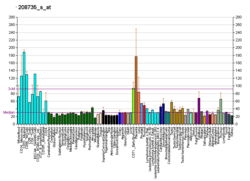CTDSP2
Carboxy-terminal domain RNA polymerase II polypeptide A small phosphatase 2 is an enzyme that in humans is encoded by the CTDSP2 gene.[5][6][7]
Interactions
References
- 1 2 3 GRCh38: Ensembl release 89: ENSG00000175215 - Ensembl, May 2017
- 1 2 3 GRCm38: Ensembl release 89: ENSMUSG00000078429 - Ensembl, May 2017
- ↑ "Human PubMed Reference:".
- ↑ "Mouse PubMed Reference:".
- ↑ Su YA, Lee MM, Hutter CM, Meltzer PS (Oct 1997). "Characterization of a highly conserved gene (OS4) amplified with CDK4 in human sarcomas". Oncogene. 15 (11): 1289–94. doi:10.1038/sj.onc.1201294. PMID 9315096.
- ↑ Yeo M, Lin PS, Dahmus ME, Gill GN (Jul 2003). "A novel RNA polymerase II C-terminal domain phosphatase that preferentially dephosphorylates serine 5". J Biol Chem. 278 (28): 26078–85. doi:10.1074/jbc.M301791200. PMID 12721286.
- ↑ "Entrez Gene: CTDSP2 CTD (carboxy-terminal domain, RNA polymerase II, polypeptide A) small phosphatase 2".
- ↑ Wu, Yadi; Evers B Mark; Zhou Binhua P (Jan 2009). "Small C-terminal domain phosphatase enhances snail activity through dephosphorylation". J. Biol. Chem. United States. 284 (1): 640–8. doi:10.1074/jbc.M806916200. ISSN 0021-9258. PMC 2610500. PMID 19004823.
Further reading
- Su YA, Trent JM, Guan XY, Meltzer PS (1994). "Direct isolation of genes encoded within a homogeneously staining region by chromosome microdissection". Proc. Natl. Acad. Sci. U.S.A. 91 (19): 9121–5. Bibcode:1994PNAS...91.9121S. doi:10.1073/pnas.91.19.9121. PMC 44759. PMID 8090779.
- Beutler E, Gelbart T, West C, et al. (1996). "A strategy for cloning the hereditary hemochromatosis gene". Blood Cells Mol. Dis. 21 (3): 207–16. doi:10.1006/bcmd.1995.0024. PMID 8673473.
- Strausberg RL, Feingold EA, Grouse LH, et al. (2003). "Generation and initial analysis of more than 15,000 full-length human and mouse cDNA sequences". Proc. Natl. Acad. Sci. U.S.A. 99 (26): 16899–903. Bibcode:2002PNAS...9916899M. doi:10.1073/pnas.242603899. PMC 139241. PMID 12477932.
- Brandenberger R, Wei H, Zhang S, et al. (2005). "Transcriptome characterization elucidates signaling networks that control human ES cell growth and differentiation". Nat. Biotechnol. 22 (6): 707–16. doi:10.1038/nbt971. PMID 15146197.
- Gerhard DS, Wagner L, Feingold EA, et al. (2004). "The status, quality, and expansion of the NIH full-length cDNA project: the Mammalian Gene Collection (MGC)". Genome Res. 14 (10B): 2121–7. doi:10.1101/gr.2596504. PMC 528928. PMID 15489334.
- Kimura K, Wakamatsu A, Suzuki Y, et al. (2006). "Diversification of transcriptional modulation: large-scale identification and characterization of putative alternative promoters of human genes". Genome Res. 16 (1): 55–65. doi:10.1101/gr.4039406. PMC 1356129. PMID 16344560.
- Thompson J, Lepikhova T, Teixido-Travesa N, et al. (2006). "Small carboxyl-terminal domain phosphatase 2 attenuates androgen-dependent transcription". EMBO J. 25 (12): 2757–67. doi:10.1038/sj.emboj.7601161. PMC 1500849. PMID 16724108.
External links
- CTDSP2 human gene location in the UCSC Genome Browser.
- CTDSP2 human gene details in the UCSC Genome Browser.
- Human SCP2 genome location and SCP2 gene details page in the UCSC Genome Browser.
This article is issued from
Wikipedia.
The text is licensed under Creative Commons - Attribution - Sharealike.
Additional terms may apply for the media files.




